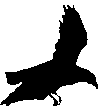
|
Dragons
The Chinese dragon is a long and slithery thing, seventy-five metres of claws - sharp teeth and slimy green scales, a threat to men and maidens both; of the kind St George fought and killed. Now days they’re all extinct, at least in Europe. - Probably not many left in china either. Always a thing to be feared, they’re not much missed remembered only in ritual and traditional forms.
~ ~ ~
The Welsh dragon is a different thing completely, short, between thirty and forty centimetres high, ginger haired, with rough and patchy coat, which some think is scaly, with rudimentary tufts at its shoulder blades, like small wings and a long rather heavy tail it drags behind. A shy animal, which keeps away from people, hiding in isolated areas. In its habitat usually quite difficult to see.
~ ~ ~
Occasionally in the more remote parts of the Brecon Beacons or Black Mountains, you can see it scampering, with its ridiculous bounding gait, looking to the left or right at the top of each bound, or its quiet sprightly flight, from where coal scree outcrops on the hillsides. Eating coal fuels its breathing and sometimes in very dry autumns, it sets the gorse alight.
~ ~ ~
Mostly confined to the south they have on occasion been seen as far north as Snowdon and the Lleyn Peninsular, but beyond that, in Lancashire or Cumbria, it’s much too harsh, they can't cope with England’s bleak and inhospitable weather and cold bite of desolation. They thrive in those parts where the anthracite is best. No one knows what will happen to them now that the mines are closing.
~ ~ ~
Protected as an endangered species they are not allowed to be hunted, captured or shown in zoos, or filmed with David Attenborough for television. Wardens patrol their breeding grounds, warning off intruders so as not to disturb these timid creatures. But if you walk quietly, in the more wild parts, in harmony with nature all around you, they can be seen, if only fleetingly, I assure you.
|
